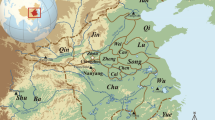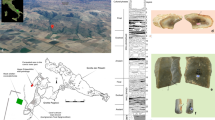Abstract
X-ray fluorescence analysis study of 44 archaeological pottery samples collected from Tell Jendares site north-west of Syria has been carried out. Four samples of the total previous investigated samples were obtained from the kiln found on Tell Jendares site. Seventeen different chemical elements were determined. The XRF results have been processed using two multivariate statistical cluster and factor analysis methods in order to determine the similarities and correlation between the selected samples based on their elemental composition. The methodology successfully separates the samples where three distinct chemical groups were discerned.



Similar content being viewed by others
References
Glascock MD (1992) Characterization of archaeological ceramics at MURR by neutron activation analysis and multivariate statistics. In: Neff H (ed) Chemical characterization of ceramic pastes in archaeology. Prehistory Press, Madison, pp 11–26
Tite MS (1999) J Archaeol Method Theory 6:181
Sayre EV, Dodson RW (1957) Am J Archaeol 61:35
Bakraji EH, Radioanal J (2005) Nucl Chem 264:645
Munita CS, Paiva RP, Alves MA, De Oliveira PMS, Momose EF (2000) J Trace Microprobe Tech 18:381
Bakraji EH, Othman I, Sarhil A, Al-somel N (2002) J Trace Microprobe Tech 20:57
Fleming SJ, Swann CP (1992) Nucl Instrum Method Phys Res Sect B 64:528
Čechák T, Hložek M, Musílek L, Trojek T (2007) Nucl Instrum Method Phys Res Sect B 263:54
Ruvalcaba-Sil JL, Ontalba Salamanca MA, Manzanilla L, Miranda J, Cañetas Ortega J, López C (1999) Nucl Instrum Method Phys Res Sect B 150:591
Pio S, Prati P, Zucchiatti A, Lucarelli F, Mandò PA, Varaldo C (1996) Nucl Instrum Method Phys Res Sect B 117:311
Roumie M, Reynolds P, Atallah C, Bakraji E, Zahraman K, Nsouli B (2006) Nucl Instrum Method Phys Res Sect B 249:612
Bakraji EH (2004) Instrum Sci Technol 32:263
Bakraji EH (2006) X-Ray Spectrom 35:190
Kilikoglou V, Bassiakos Y, Doonan RC, Stratis J (1997) J Radioanal Nucl Chem 216:87
Feretti M (2000) In: Creagh DC, Bradley DA (eds) Radiation in art and archaeometry. Elsevier, Amsterdam, p 285
Mantler M, Schreiner M (2000) X-ray Spectrom 29:3
Pollard A, Hoilund F (1985) Archaeometry 25:196
Yap C, Tang SM (1984) Archaeometry 26:78
Hampel H (1984) In: Hughes R (ed) Obsidian studies in the great basin. Archaeological Research Facility, University of California Berkeley, p 21
Potts P (1987) A handbook of silicate rock analysis. Chapman and Hall, New York
IAEA (2005) Quantitative X-ray analysis system, QXAS, Doc, Version 2.0
Bieber AM, Brooks DW, Harbotte G, Sayre EV (1976) Archaeometry 18:59
Acknowledgements
The author wishes to thank the International Atomic Energy Agency (project ARASIA/1/010) and Prof. I. Othman Director General of AEC of Syria and Dr. B. Jamous Director General of antiquity and museum in Damascus for their supporting of this work.
Author information
Authors and Affiliations
Corresponding author
Rights and permissions
About this article
Cite this article
Bakraji, E.H., Itlas, M., Abdulrahman, A. et al. X-ray fluorescence analysis for the study of fragments pottery excavated at Tell Jendares site, Syria, employing multivariate statistical analysis. J Radioanal Nucl Chem 285, 455–460 (2010). https://doi.org/10.1007/s10967-010-0595-4
Received:
Published:
Issue Date:
DOI: https://doi.org/10.1007/s10967-010-0595-4




